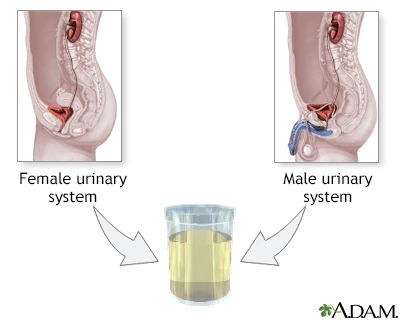Delta-ALA urine test
Definition
Delta-ALA is a protein (amino acid) produced by the liver. A test can be done to measure the amount of this substance in the urine.
Alternative Names
Delta-aminolevulinic acid
How the Test is Performed
Your health care provider will ask you to collect your urine at home over 24 hours. This is called a 24-hour urine sample. Your provider will tell you how to do this. Follow instructions exactly.
How to Prepare for the Test
Your provider may tell you to temporarily stop taking any medicines that can affect test results. Be sure to tell your provider about all the medicines you take. These include:
- Penicillin (an antibiotic)
- Barbiturates (medicines to treat anxiety)
- Birth control pills
- Griseofulvin (medicine to treat fungal infections)
How the Test will Feel
The test involves only normal urination. There is no discomfort.
Why the Test is Performed
This test looks for an increased level of delta-ALA. It may be used to help diagnose a blood disorder called porphyria.
Normal Results
Normal value range for adults is 1.0 to 7.0 mg (7.6 to 53.3 mol/L) over 24 hours.
Normal value ranges may vary slightly from one lab to another. Some labs use different measurements or test different samples. Talk to your provider about the meaning of your specific test results.
What Abnormal Results Mean
An increased level of urinary delta-ALA may indicate:
- Lead poisoning
- Porphyria (several types)
A decreased level may occur with chronic (long-term) liver disease.
Risks
There are no risks with this test.
Gallery

References
Fuller SJ, Wiley JS. Heme biosynthesis and its disorders: porphyrias and sideroblastic anemias. In: Hoffman R, Benz EJ, Silberstein LE, et al, eds. Hematology: Basic Principles and Practice. 7th ed. Philadelphia, PA: Elsevier; 2018:chap 38.
Squires JE, Balistreri WF. Other inherited metabolic disorders of the liver. In: Feldman M, Friedman LS, Brandt LJ, eds. Sleisenger and Fordtran's Gastrointestinal and Liver Disease. 11th ed. Philadelphia, PA: Elsevier; 2021:chap 77.